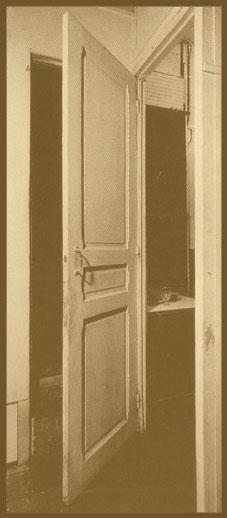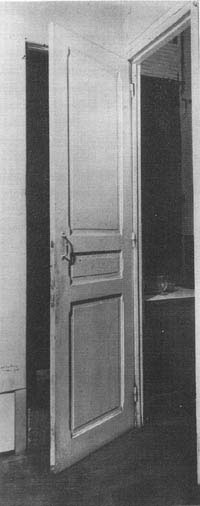
Door, 11 rue Larrey
 |
| Original version, 1927 |
|
Original Version:
1927, New York |
A carpenter made this wooden door according to Duchamp's specifications. As a direct consequence of this, Door, 11 rue Larrey succeeds in questioning the role of the artist and notion of authorship. According to the more traditional definition of the term, it appears the craftsman is the artist more so than Duchamp. However, it was Duchamp's plan and ideas that guided the craftsman to create the window in the first place. Duchamp is thus commenting that the artist does not necessarily have to be the one to physically create a piece; the importance of his role lies in his mind and his ideas, not necessarily his hand. In a way, Duchamp is pointing out that anyone can make things, but only the true artist can create things that have ideas and depth at their core. Thus, Door, 11 rue Larrey takes the concept communicated by the earlier, more pure Readymades a step further.
In this late Readymade, Duchamp made sure that the alternative to the artist - the maker - was a (seemingly) identifiable individual in society. (However, the author couldn't find any record of his actual name.) With his earlier works, Duchamp just assumed an anonymous individual who mindlessly created the physical objects that the artist later found, purchasing them directly out of the store window. The Door brings in the idea of personalized craftsmanship more so than many other (predominantly early) Readymades that were simply purchased and then variably altered.
Originally part of the artist's studio at 11 rue Larrey, Paris, this one door serves two doorways. As a result, when it swings on its hinges to close entrance to one room, it opens another, therefore defying the French proverb "A door must be either open or shut." Door, 11 rue Larrey thus clearly illustrates Duchamp's rejection of simple "clean-cut solutions" (Schwarz 206). This idea is integral to Duchamp's approach to art making. This may be seen in the following famous comment made by the artist: "Il n'y a pas de solution parce qu'il n'y a pas de probleme" ("There is no solution because there is no problem" (Arman 104).
In 1963, the original version of this piece was removed from its on-site context and began to be shown as an independent piece of artwork.
Replicas:
2) 1963, Milan
3) 1963, Paris

Replica, 1963
1) 1961, Amsterdam
Made by K. G. Pontus Hulten and Daniel Spoerri
Destroyed at close of exhibition
Collection of Alexina Duchamp, France
Collection of Arturo Schwarz, Milan
Two full-scale photographs taken on-site
Made by carpenter
Wood door, replacing original version (purchased by Cordier and Ekstrom, New York)